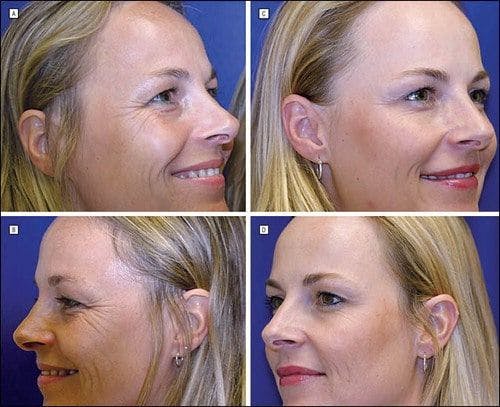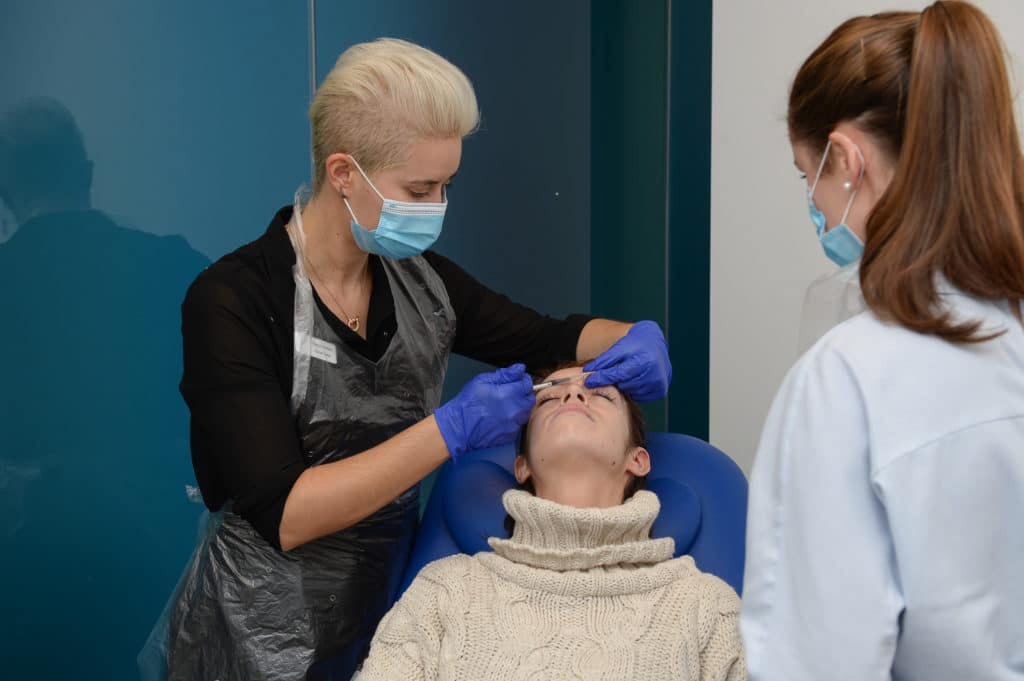How Botox Can Improve Skin Quality Over Time

When thinking of botulinum toxin, both patients and injectors can see it as a “quick fix”. There is increasing evidence, however, that botox can improve skin quality over time when used appropriately.
This can mean applying a range of techniques outside injecting the traditional wrinkle-relaxing points. Here we look at some of the benefits associated with long-term botox use in its different applications.
Twin study into long term effects of Botox
Many studies examine the immediate or short-term effects of toxins when used to relax wrinkles in specific areas of concern. However, a 2006 trial used identical female twins to show the long-term benefits of Botox.
One twin (Twin B) received regular Botox to the forehead and glabellar areas for 13 years – roughly two-to-three times per year) – and also treated her crow’s feet twice in the past two years. The other twin (Twin A) received Botox twice during the same period – once in the forehead, three years ago and once in the glabellar region, seven years ago. Continues below.

Crow’s feet appear to be more prominent in Twin A, seen here in the left hand column images (A and B), rather than Twin B on the right, who received regular Botox treatments over the past 13 years (Image: Long-Term Effects of Botulinum Toxin Type A (Botox) on Facial Lines, Archives of Facial Plastic Surgery, Vol. 8, No. 6, doi.org/10.1001/archfaci.8.6.426
Researchers determined: “Long-term treatment with Botox can prevent the development of imprinted facial lines that are visible at rest. Botox treatment can also reduce crow’s feet. Treatment is well tolerated, with no adverse events reported during 13 years of regular treatment in this study.
Hyperfunctional lines such as horizontal forehead lines, glabellar lines, and crow’s feet can develop from the repeated contractions of certain muscles (the frontalis, procerus, corrugator, and orbicularis oculi muscles). By blocking the release of acetylcholine from the presynaptic terminal of the neuromuscular junction, botulinum toxin type A (Botox; Allergan Inc, Irvine, Calif) can inhibit the contraction of these muscles.”
This study, which was carried out by UCLA School of Medicine, Los Angeles, USA, is often cited by aesthetics practitioners when explaining the long-term benefits of “regular” botox to patients.
Improving skin quality
The twin study touches on how, by preventing facial creasing, the skin is less stressed and has more time to repair itself. Newer studies have gone further, showing how novel injector techniques and toxin applications can target sebaceous secretions and superficial fibres in the facial muscles for skin improvements.
A November 2020 study into microbotulinium – more commonly known as “micro botox” or “baby botox” – was shown to offer additional benefits to skin texture.
Administering microbotulinium involves placing a series of small, diluted botulinum toxin “blebs” just under the skin’s surface in a grid pattern, at 1cm intervals.
This Italian research, published in the Journal of the American Society of Plastic Surgeons, showed how this new method could be used to “treat skin flaws” including microroughness and enlarged pores.
“This targets the superficial fibres of the facial muscles and weakens their insertion into the undersurface of the skin, which is responsible for the fine lines and wrinkles on the face and neck,” write the study authors.
An extremely high patient satisfaction rating was found among this study’s participants. Of the 60 patients who completed the trial, 95 percent reported being “satisfied” or “very satisfied” with their results at a 90-day check-up. Those in their mid-thirties to early-fifties saw the best results.
The study concludes: “The results of this pilot study suggest that intradermal botulinum toxin injection, or so-called microbotulinum, is a safe and effective method to treat skin flaws. Because of the high satisfaction rate among both physicians and patients, further studies are indeed mandatory to determine the optimal number of units needed for a longer and lasting effect with this particular novel dilution.”
Whilst the hypothesis is that micro botox could improve the outlined skin issues with long-term use, further research is needed to prove this.
Getting started with injecting Botox

Harley Academy creative director and aesthetics specialist, Dr Marcus Mehta notes: “The development of the use of botulinum toxin, including microbotulinum, is really interesting.
Medically, botulinum toxin can be used to treat hyperhidrosis and harnessing its ability to affect sebaceous glands and decrease sebum production is an exciting new use for the drug.
Before experimenting with these newer applications, however, it is important to ensure you have the basics down and really perfect your injecting techniques.”
For licensed medical professionals wishing to add aesthetics skills to their repertoire, the Level 7 Diploma in Botox and Dermal Fillers is the gold standard in injectables education.
Doctors, dentists, nurses and midwives can enjoy Master’s level aesthetic medicine training courses with a flexible schedule to fit around your existing commitments. The mix of online learning and hands-on expert tuition includes premium quality videos and protocol information that you can use as reference tools throughout your aesthetics career.
For those who would like to refresh or improve their injecting skills – especially after the lockdown break! – a one-to-one learning experience, with tailored guidance from an experienced trainer, can provide a valuable career edge. Book a dedicated One-to-One Injectables Training session in the area you’d particularly like to focus on, to boost your confidence and skill level.
Building a solid foundation of excellent injecting skills, along with the crucial facial anatomy and ageing information, will allow you to move on to exploring these newer techniques and really developing the artistic side of your aesthetics practice. Just don’t try to run before you can walk!
All information correct at the time of publication
Download our full prospectus
Browse all our injectables, dermal fillers and cosmetic dermatology courses in one document
By submitting this form, you agree to receive marketing about our products, events, promotions and exclusive content. Consent is not a condition of purchase, and no purchase is necessary. Message frequency varies. View our Privacy Policy and Terms & Conditions
Attend our FREE open evening
If you're not sure which course is right for you, let us help
Join us online or in-person at our free open evening to learn more
Our Partners













STAY INFORMED
Sign up to receive industry news, careers advice, special offers and information on Harley Academy courses and services

